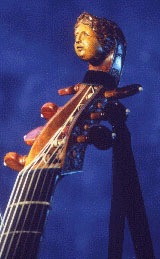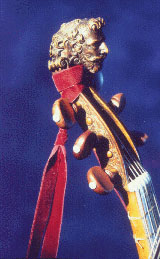The viola da gamba
 “… the human Voice… never has an Instrument imitated it as well as the Viol…”
“… the human Voice… never has an Instrument imitated it as well as the Viol…”
Jean Rousseau, Traité de la viole, 1687.
The viol, a bowed string instrument, flourished in the courts and noble households of Europe during the seventeenth and eighteenth centuries. The viola da gamba family differs from the viola da braccia family (violin, viola, cello and double-bass) in several ways: all sizes of viols, from small to large, are held between the legs, fretted like the guitar and bowed “underhand”.
While the violin served to enliven plebeian street festivities, the viol was the instrument par excellence of the nobility. A chest of viols, treble, tenor and bass, was a commonly found accessory in any aristocratic household where playing in consort or improvising divisions on a bass, for the virtuosi, would be one of the most beloved forms of entertainement.
 Marin Marais, famous French gambist and virtuoso appointed to the court of the Sun King, wrote over five hundred pieces for the instrument as well as chamber music and operas. He had been a student of the mysterious Monsieur de Sainte-Colombe. Both form the subject of the film Tous les matins du monde which was universally hailed by critics and public alike for the beauty of the music.
Marin Marais, famous French gambist and virtuoso appointed to the court of the Sun King, wrote over five hundred pieces for the instrument as well as chamber music and operas. He had been a student of the mysterious Monsieur de Sainte-Colombe. Both form the subject of the film Tous les matins du monde which was universally hailed by critics and public alike for the beauty of the music.
The eighteenth century saw the rise of the middle class, popular music and the predominance of the violin. The viola da gamba gradually declined in popularity with the eclipse of the nobility and the ultimate destruction of the French court, after the revolution.
The beauty, intimacy and refinement of the sound of the viola da gamba, contrasted with the audacious extravagance of the repertoire, seems to strike a responsive chord in the contemporary music lover. Thus the renaissance in popularity of this exotic instrument.


Nothing Found
Sorry, no posts matched your criteria